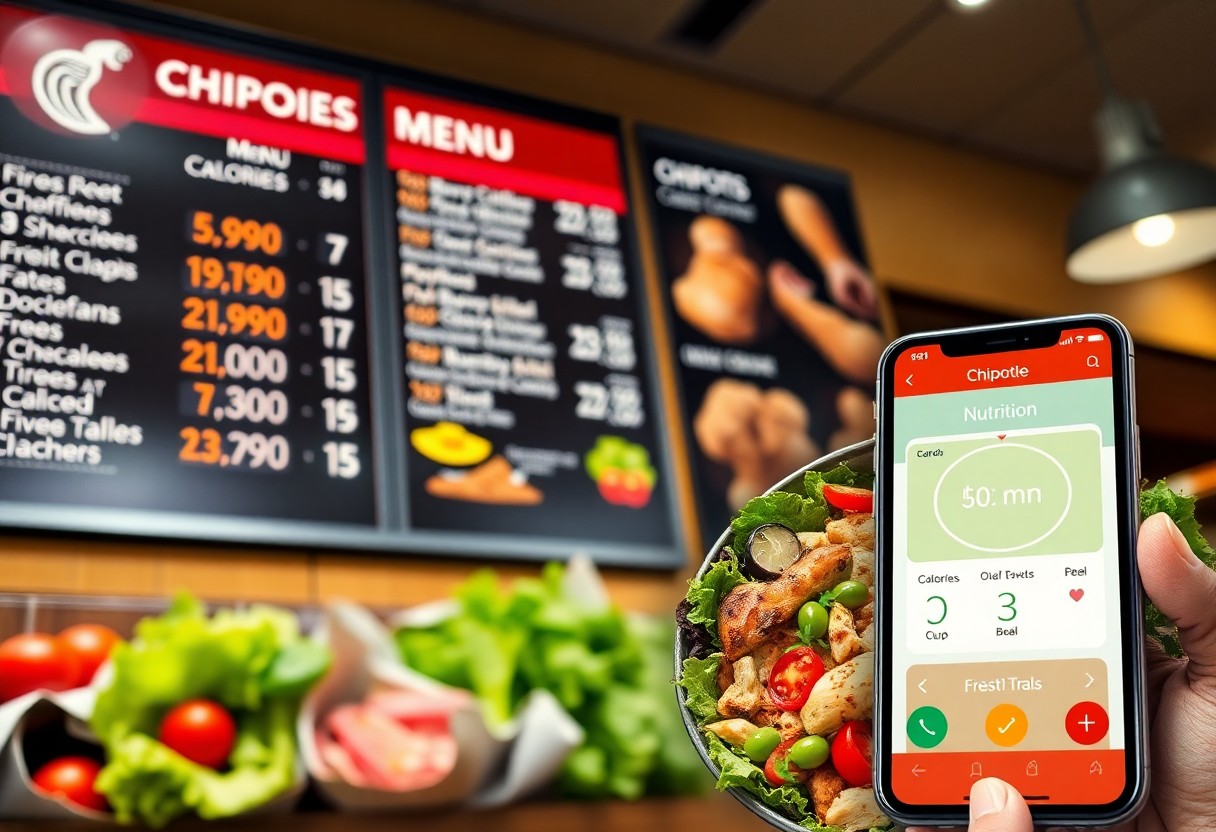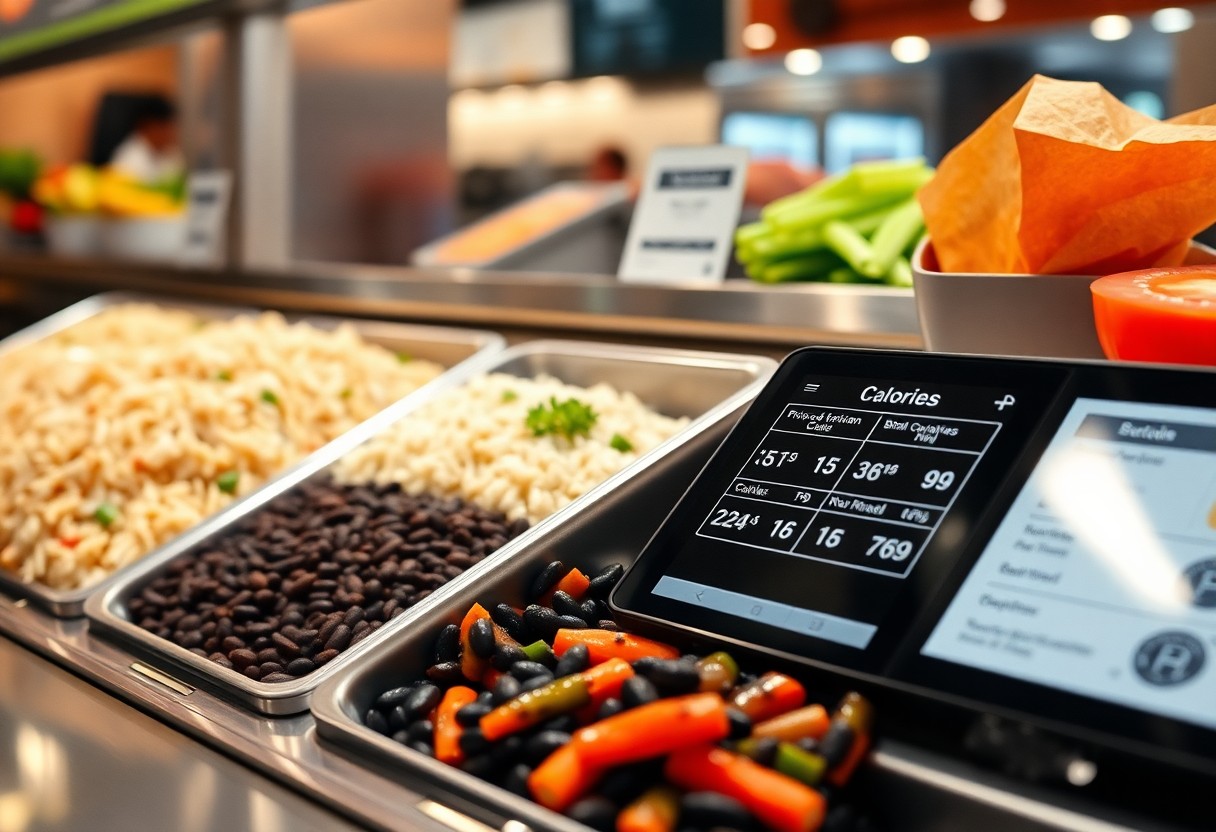There's a wealth of options at Chipotle that can align with your health goals, but navigating the menu can be overwhelming. To help you make informed choices, this guide provides insights into calorie counts, ingredient breakdowns, and practical tips for customizing your meals. By understanding your nutritional needs and utilizing the Chipotle calorie counter, you can enjoy satisfying meals that support your lifestyle while tracking your nutrition effectively.

Key Takeaways:
- Utilize the Chipotle nutrition calculator to monitor calorie intake and macronutrient distribution.
- Opt for healthier toppings and modifications, such as limiting cheese and sour cream, to enhance nutritional value.
- Portion control is crucial; consider customizing portion sizes to manage calorie consumption effectively.
Understanding Chipotle's Menu
Chipotle's menu offers a variety of customizable options, allowing you to choose ingredients that suit your dietary needs. From burritos to salads, every item can be tailored for a nutritious meal. For specific guidance on selecting healthier ingredients, check out this Healthy Chipotle Bowl: How to Order According ... article.
Nutritional Breakdown of Common Items
Understanding the nutritional content of Chipotle's popular menu items allows you to make informed choices. For instance, a chicken burrito contains approximately 700 calories, whereas a burrito bowl without the tortilla can be around 600 calories. The difference in calories often comes from tortillas and excess toppings, so knowing what each contributes is vital for tracking your nutrition.
High-Calorie vs. Low-Calorie Options
Identifying high-calorie and low-calorie options at Chipotle can significantly impact your meal planning. Burritos, especially with added cheese and sour cream, can push calorie counts above 1,000. In contrast, salads or bowls with lean proteins and veggies keep calorie counts lower while maintaining fullness and satisfaction.
For a deeper understanding, a burrito with barbacoa, rice, and guacamole can hover around 1,200 calories. However, choosing whole ingredients like black beans, grilled chicken, and lots of greens can keep your meal closer to 500-700 calories, making it a satisfying yet weight-conscious choice. Balancing your preferences with low-calorie options can enhance your overall dining experience and promote healthier eating habits.
Building a Healthy Bowl
Creating a nutritious bowl at Chipotle involves making mindful choices from the wide array of ingredients available. By strategically selecting your base, proteins, and toppings, you can enjoy a satisfying meal that aligns with your health goals while indulging in bold flavors. A focus on portion control and nutrient balance will help you get the most out of your Chipotle experience.
Choosing the Right Base
Your bowl's base significantly impacts its overall calorie and nutritional content. Opt for brown rice or lettuce instead of white rice, as brown rice provides more fiber and nutrients. If you're looking to reduce carbs, lettuce is an excellent low-calorie option that adds a satisfying crunch while keeping your bowl light and refreshing.
Selecting Your Proteins and Toppings
The choice of proteins and toppings can elevate your bowl nutritionally. Chicken and sofritas are leaner options, providing protein without excessive calories. Consider limiting high-calorie toppings like sour cream and cheese. Instead, add flavor with options like pico de gallo or salsa, which enhance taste without loading on calories.
Choosing the right proteins and toppings involves balancing flavor and nutrition effectively. Chicken offers 180 calories per serving, while steak contains 150 calories but fewer saturated fats. For a plant-based option, sofritas provide 150 calories with a robust taste. Adding beans, such as black or pinto, not only boosts protein but also increases fiber intake. Toppings like fajita vegetables add vitamins without many calories, while fresh salsas contribute zest and hydration, ensuring your bowl is both delicious and nutritious.
Managing Caloric Intake
Balancing your caloric intake while enjoying Chipotle can enhance your overall health journey. By making informed choices and being mindful of portion sizes, you can savor your meal without exceeding your daily limits. For tips on how to stay on track while dining out at Chipotle, check out How To Stay on Track While Dining Out at Chipotle. Focus on balancing indulgence with nutritional needs to maintain a healthy lifestyle.
Portion Control Strategies
Controlling portions at Chipotle is vital to managing your caloric intake. Opt for a smaller bowl or burrito and choose to skip extras like chips and guacamole if you're not hungry. By prioritizing lean proteins and loading up on vegetables, you can enjoy a hearty meal that's lower in calories. Paying attention to serving sizes can make all the difference in reaching your nutritional goals.
Utilizing Chipotle's Nutrition Calculator
Chipotle makes it easy to track your nutrition through its online nutrition calculator. You can customize your meal and see the calorie count for each ingredient, allowing you to make better choices based on your dietary needs. By experimenting with different combinations, you can find meal options that satisfy your cravings while keeping your caloric intake in check.
The nutrition calculator not only displays total calories but also breaks down macronutrients, enabling you to manage your protein, fat, and carbohydrate intake effectively. This feature is particularly useful if you're following specific dietary plans, such as low-carb or high-protein diets. By utilizing this tool, you can craft a meal that aligns with your nutritional goals while enjoying the flavors that Chipotle has to offer.
The Role of Sides and Drinks
Sides and beverages often can significantly increase your caloric intake, so you need to choose wisely. Items like chips and guacamole might be popular, but they add empty calories quickly. Instead, focus on balancing your meal by selecting lighter options that can enhance your experience without derailing your nutritional goals.
Healthy Side Options
Beverage Choices That Keep Calories Low
Selecting beverages thoughtfully is key to minimizing caloric intake. Water, unsweetened iced tea, or zero-calorie drinks are ideal options. Avoid sugary sodas and sweetened beverages that can add up to hundreds of calories in a single meal.
Beverages can play a significant role in your overall calorie count at Chipotle. Consider that a regular soda can cost you about 150 to 300 calories. Opting for a refreshing water or a cup of unsweetened iced tea not only quenches your thirst but effectively keeps your caloric intake low. Additionally, Chipotle offers options like sparkling water, which provides a bit of fizz with zero calories, making it a smart choice.
Tips for Eating Out Healthily
When dining out, making healthier choices requires awareness and strategic selections. Start by reviewing the menu beforehand, as many places provide nutritional information online. Opt for smaller portion sizes, choose grilled over fried options, and prioritize fresh ingredients. Opting for water instead of sugary beverages can significantly lower your calorie intake.
- Always check portion sizes.
- Replace heavy sauces with lighter alternatives.
- Focus on vegetables as a primary component.
- Customize your meal to suit your nutritional needs.
The key is to take a proactive approach to your dining experience.
Mindful Eating Practices
Engaging in mindful eating techniques can transform your dining experience. Focus on each bite, savor the flavors, and pay attention to your body's hunger cues. Eating slowly allows you to enjoy your meal while also recognizing when you feel satisfied, reducing the likelihood of overeating.
Making Informed Choices
Making informed choices at Chipotle involves understanding the nutritional value of each component of your meal. Identify calorie-dense ingredients and balance them with lighter options. Use the nutritional information available to customize your bowl or burrito effectively, ensuring that you meet your dietary goals without sacrificing flavor.
Consult the online nutrition calculator to analyze potential combinations. For instance, swapping sour cream for pico de gallo can save you around 100 calories. Follow the guideline of filling half your bowl with vegetables and opting for lean proteins like chicken or sofritas over beef. Knowledge of the nutritional content helps you create satisfying meals that align with your health objectives.
Tracking Your Nutrition
Tracking your nutrition is vital for reaching your health goals. By monitoring the calories, macronutrients, and portion sizes of your meals, you gain insight into your dietary habits, making it easier to adjust your choices at Chipotle and beyond. Keeping a detailed log allows you to identify patterns and make informed decisions that align with your wellness journey.
Using Apps and Tools
Utilizing nutrition tracking apps can simplify the process of monitoring your calorie intake. Tools like MyFitnessPal and Lose It! allow you to scan barcodes, input meals, and track your progress effortlessly. These platforms also provide insights into your macronutrient breakdown, helping you to stay accountable to your health goals while enjoying your meals.
Setting Personal Caloric Goals
Establishing personal caloric goals tailors your nutrition plan to your individual needs. Depending on factors like age, weight, activity level, and health objectives, your caloric intake should support your fitness ambitions. Consider using formulas such as the Mifflin-St Jeor equation for calculating your Basal Metabolic Rate (BMR) and then adjust based on your activity level to find your Total Daily Energy Expenditure (TDEE).
To set effective personal caloric goals, first determine your BMR, which is the amount of energy your body requires at rest. For instance, a 30-year-old woman weighing 150 pounds may have a BMR of approximately 1,400 calories. By assessing how active you are, you can multiply this number to find your TDEE; a sedentary lifestyle might point to around 1,680 calories for maintenance. Aim for a caloric deficit for weight loss or a surplus for muscle gain, adjusting your goals as needed to stay aligned with your evolving fitness journey. Regularly revisiting and modifying these targets will keep you on track and motivated towards your health objectives.
To wrap up
Drawing together the insights from the Chipotle Calorie Counter, you can effectively track your nutrition and make healthier choices tailored to your preferences. By utilizing the calorie calculator, you empower yourself to understand the nutritional content of your meals, ensuring that your dining experience aligns with your health goals. Have YOU ever put your @chipotle order in their Calculator to see how it fits your nutritional needs? Check it out here for a practical approach to making informed decisions at Chipotle.
FAQ
Q: How can I find the calorie content of Chipotle menu items?
A: You can find the calorie content of Chipotle menu items by visiting their official website or using the Chipotle app, where nutrition information is provided for each dish. Additionally, in-store nutritional guides are available.
Q: What are some healthy customization options for my Chipotle meal?
A: For healthier meals, opt for brown rice instead of white, choose black or pinto beans for protein, load up on vegetables, select salsa instead of sour cream, and consider skipping the cheese and guacamole to reduce calories.
Q: Does Chipotle offer any low-calorie options?
A: Yes, Chipotle offers several low-calorie options. You can build a salad with lots of veggies, add a protein like chicken or steak, and use lighter dressings or salsas to keep calories minimal.
Q: Is there a way to track my daily calorie intake at Chipotle?
A: Yes, you can track your daily calorie intake by using a food diary app or nutrition tracking tool where you can log your Chipotle meals. You can also use Chipotle's nutrition calculator on their website to help with this.
Q: How can I make healthier choices when ordering at Chipotle?
A: To make healthier choices, start by choosing smaller portion sizes, prioritize whole ingredients like lettuce and beans, avoid extra toppings high in calories, and be mindful of sauces and dressings.







0 Comments